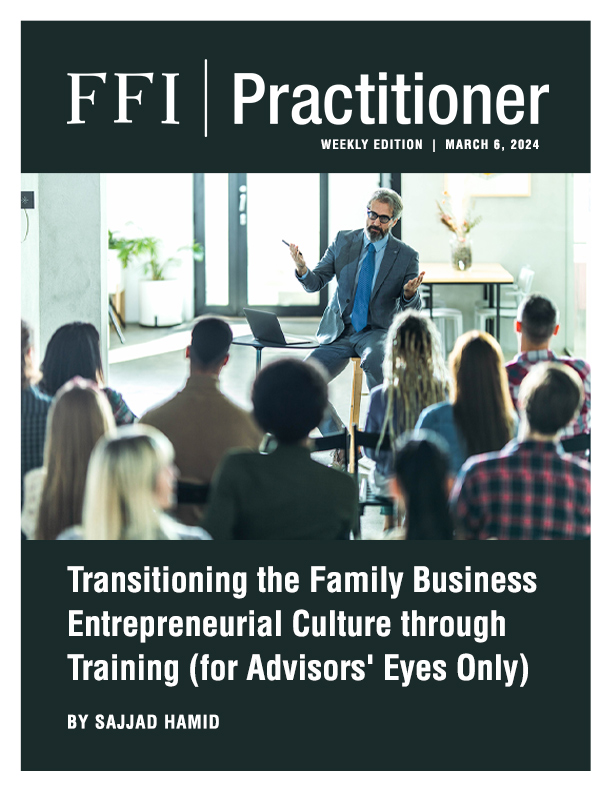
- Entrepreneurs typically work independently and have complete freedom to pursue their vision. They are responsible for developing their business plan, securing funding, and have full control over the direction of their venture.
- Intrapreneurs work within an existing organization or company.1
Facilitating Entrepreneurship and Intrapreneurship Education with Clients
Family enterprise advisors can look at expanded ways to market their knowledge resources, stretching their product strategy to include entrepreneurship and intrapreneurship education—either as a standalone paid product or a freemium strategy to gain clients with micro-learning events. While offering this type of education may be out of the norm for most advisors, it can be an additional advising offering—one that assists family enterprise clients in promoting entrepreneurial behaviour in multi-generational clients.
A decade ago, my colleagues and I decided to develop a bachelor’s degree curriculum in management and entrepreneurship at the community college level. We soon found that entrepreneurship had some pedagogical peculiarities. Specifically—how do we get students to think (and act) as entrepreneurs?
Entrepreneurship education is a relatively new field, but it is a rapidly growing discipline, as many universities and colleges now have both courses and degrees in entrepreneurship. It differs from teaching mathematics or English, which can be done almost entirely in the classroom.
Entrepreneurship training, however, requires unique approaches:
- The facilitator must consider the training needs of the organization and the target participants.
- The curriculum designer (content developer) must understand the corporate strategy and how the course outcomes can be aligned.
First, remember that subsequent generation family members and/or non-family managers may not have the same mindset as the first generation. Entrepreneurs differ from the average manager in that they think and act differently.
Sidebar
A second strategy is to use real-time simulations. These could be virtual games that trainees can play to improve their abilities in identifying opportunities and developing risk management strategies in the face of extreme uncertainty. While stimulations cannot model the real world entirely, the potential in other fields, such as weather forecasting, shows it can make predictions.
Sidebar

The Role of the Advisor as Facilitator
An advisor turned facilitator might encounter the “do-it-yourself objection” from clients—a belief that entrepreneurship can only be learned by forging ahead without assistance or training. When family business founders try to transfer entrepreneurial knowledge directly, they often face obstacles. For example, since entrepreneurs often learn from experience and experimentation, transferring this tacit knowledge can be difficult as it is specific to their own entrepreneurial history and story. The dynamic that may develop in a relationship between a mentor and mentee, coupled with close family ties, could cause conflict. There is also a danger that the entrepreneur, while successful in their own business ventures, may not necessarily have adequate mentorship or training skills. Additionally, the entrepreneurial mentor may not have the time to devote to this type of training. This is an opportunity for advisors to act as facilitators in the knowledge and skills transfer.
What About Intrapreneurship?
Can employees in a large organization practice entrepreneurship as the founders did? There is an emerging genre called intrapreneurship, where employees in a firm think and act as entrepreneurs within their organizations, despite not having ultimate decision-making authority.
Intrapreneurship is often encouraged within an organization in a variety of ways: providing space and time to employees and allowing sandbox experimentation while managing real-time risk.
Consider for example: Bernard Marcus and Arthur Blank, founders of Home Depot. Bernard and Arthur were co-workers at Handy Dan Improvement in California. During their time there, they floated the idea of a big-box home improvement store concept with their employers, but their bosses were not convinced. So, they tried an interesting business experiment by testing low prices in one location. The results were increased sales volume while cost as a percent of sales fell, leading to higher margins. Despite a profitable test, the parent company of Handy Dan was undergoing a restructuring, and the future founders of Home Depot lost their jobs.
Changing Hats—Again
The role of family enterprise advisors in continuing the legacy rests on their ability to build the future family business on a foundation of enduring entrepreneurship. However, the advisor’s mindset must change to understand how to develop an innovative pedagogical method to keep the founders’ spirit alive through generations.
Sidebar

Reference
1“What Is Intrapreneurship, and How Can You Cultivate It at Your Company?” Stanford Online, accessed February 22, 2024, https://online.stanford.edu/what-intrapreneurship-and-how-can-you-cultivate-it-your-company.





